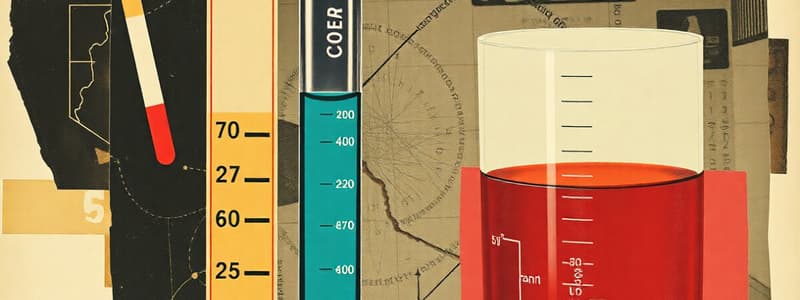Podcast
Questions and Answers
What is the positive result for the starch test?
What is the positive result for the starch test?
- Solution turns brick red
- Solution turns blue-black (correct)
- Solution remains orange-brown
- Solution turns green
Which process confirms the presence of non-reducing sugars?
Which process confirms the presence of non-reducing sugars?
- Heating a blue solution with Benedict's reagent
- Cooling the solution before testing
- Directly adding Benedict's reagent
- Boiling the acidified solution (correct)
What type of bond forms between the nucleotides in a polynucleotide chain?
What type of bond forms between the nucleotides in a polynucleotide chain?
- Peptide bonds
- Ionic bonds
- Phosphodiester bonds (correct)
- Hydrogen bonds
Which nitrogenous base is present in RNA but not in DNA?
Which nitrogenous base is present in RNA but not in DNA?
What is the primary role of mRNA in cells?
What is the primary role of mRNA in cells?
In the context of DNA replication, what does 'semi-conservative' mean?
In the context of DNA replication, what does 'semi-conservative' mean?
What is the positive indicator for proteins when Biuret reagent is added?
What is the positive indicator for proteins when Biuret reagent is added?
What does a positive lipid test indicate when a white emulsion forms?
What does a positive lipid test indicate when a white emulsion forms?
What is the role of DNA helicase in DNA replication?
What is the role of DNA helicase in DNA replication?
Which of the following best describes the main function of ATP in biological systems?
Which of the following best describes the main function of ATP in biological systems?
What occurs during the hydrolysis of ATP?
What occurs during the hydrolysis of ATP?
Which property of water contributes to its role as an excellent solvent?
Which property of water contributes to its role as an excellent solvent?
How do hydrogen ions (H+) influence biological processes?
How do hydrogen ions (H+) influence biological processes?
What is the significance of iron ions (Fe2+) in the body?
What is the significance of iron ions (Fe2+) in the body?
What is the primary function of sodium ions (Na+) in biological systems?
What is the primary function of sodium ions (Na+) in biological systems?
Which statement about phosphate ions (PO43-) is correct?
Which statement about phosphate ions (PO43-) is correct?
Flashcards
Starch Test
Starch Test
A biochemical test used to identify the presence of starch in a sample. Iodine solution is added to the sample, and a positive result is indicated by a color change from orange-brown to blue-black.
Reducing Sugars Test
Reducing Sugars Test
A test used to identify the presence of reducing sugars in a sample. Benedict's reagent is added to the sample and heated. A positive result is indicated by a color change from blue to green, yellow, orange, or brick red. The intensity of the color indicates the concentration of reducing sugars.
Non-Reducing Sugars Test
Non-Reducing Sugars Test
A test used to identify the presence of non-reducing sugars in a sample. The sample is initially tested for reducing sugars using Benedict's reagent. If the result is negative (remains blue), the sample is then hydrolyzed with acid and heated. After cooling and neutralizing, Benedict's reagent is added again. A positive result is indicated by a color change to orange or brick red.
Proteins Test
Proteins Test
Signup and view all the flashcards
Lipids Test
Lipids Test
Signup and view all the flashcards
DNA (Deoxyribonucleic Acid) Function
DNA (Deoxyribonucleic Acid) Function
Signup and view all the flashcards
DNA Structure
DNA Structure
Signup and view all the flashcards
DNA Replication (Semi-Conservative)
DNA Replication (Semi-Conservative)
Signup and view all the flashcards
DNA replication
DNA replication
Signup and view all the flashcards
Semi-conservative replication
Semi-conservative replication
Signup and view all the flashcards
DNA helicase
DNA helicase
Signup and view all the flashcards
DNA polymerase
DNA polymerase
Signup and view all the flashcards
ATP (Adenosine Triphosphate)
ATP (Adenosine Triphosphate)
Signup and view all the flashcards
ATP hydrolysis
ATP hydrolysis
Signup and view all the flashcards
Phosphorylation
Phosphorylation
Signup and view all the flashcards
Inorganic Ions
Inorganic Ions
Signup and view all the flashcards
Study Notes
Biochemical Tests
- Starch Test:
- Add iodine solution.
- Positive result: orange-brown iodine turns blue-black.
- Identifies starch presence.
- Reducing Sugars Test:
- Add Benedict's reagent and heat.
- Positive result: blue solution turns green, yellow, orange, or brick red.
- Color intensity indicates reducing sugar concentration (red = high concentration).
- Non-Reducing Sugars Test:
- Perform Benedict's test first.
- If negative, add acid and boil.
- Cool and neutralize.
- Heat and add Benedict's reagent again.
- Positive result: solution turns orange or brick red.
- Non-reducing sugars (e.g., sucrose) hydrolyze into reducing sugars (e.g., glucose, fructose) thus always giving a positive result.
- Proteins Test:
- Add Biuret reagent (blue).
- Positive result: solution turns purple.
- Lipids Test:
- Dissolve sample in ethanol, shake.
- Add distilled water.
- Positive result: white emulsion (milky texture).
DNA (Deoxyribonucleic Acid)
- Function:
- Determines amino acid sequence in proteins.
- Holds the genetic code.
- Transmits genetic information.
- Structure:
- Two polynucleotide chains forming a double helix.
- Monomer: nucleotide (phosphate group, deoxyribose sugar, nitrogenous base).
- Polynucleotide Formation:
- Condensation reactions link nucleotides.
- Phosphodiester bonds form.
- Strong sugar-phosphate backbone results.
- Double Helix Formation:
- Hydrogen bonds between complementary base pairs (cytosine-guanine, adenine-thymine).
RNA (Ribonucleic Acid)
- Structure:
- Similar to DNA, but with differences:
- Pentose sugar is ribose.
- Uracil replaces thymine.
- Similar to DNA, but with differences:
- Polymer:
- Shorter than DNA.
- Often single-stranded.
- Function:
- mRNA: carries gene copies.
- tRNA: involved in protein synthesis.
- rRNA: combines with proteins to form ribosomes (critical for protein synthesis).
DNA Replication
- Semi-Conservative Replication:
- One original strand combines with a newly synthesized strand.
- Steps:
- DNA helicase unwinds by breaking hydrogen bonds.
- Strands separate to act as templates.
- Free nucleotides align with their complements.
- DNA polymerase joins nucleotides.
- Phosphodiester bonds form.
- Evidence:
- Watson and Crick: discovered DNA's double helix structure.
- Meselson and Stahl: experimentally proved semi-conservative replication.
ATP (Adenosine Triphosphate)
- Structure:
- Nucleotide derivative.
- Three phosphate groups.
- Ribose sugar.
- Adenine base.
- Function:
- Immediate energy source for metabolism.
- Production:
- ADP and inorganic phosphate combine (condensation reaction), catalyzed by ATP synthase.
- Energy Release:
- Hydrolysis (breaking phosphate bonds) releases energy.
- Catalyzed by ATP hydrolase.
- Phosphorylation:
- Phosphate group transferred to other compounds, increasing reactivity.
Water
- Properties:
- Metabolite: involved in reactions (condensation, hydrolysis, photosynthesis).
- Excellent solvent: dissolves substances, aids transport.
- High heat capacity: prevents temperature fluctuations, protects enzymes.
- Large latent heat of vaporization: cooling effect (sweat, transpiration).
- Strong cohesion (hydrogen bonds): allows continuous water columns in plants (xylem), provides surface tension.
Inorganic Ions
- Importance:
- Found in solutions (cytoplasm, blood).
- Variable concentrations.
- Key Ions and Functions:
- Hydrogen ions (H+):
- Affect pH (enzymes, hemoglobin), role in chemiosmosis (respiration, photosynthesis).
- Iron ions (Fe2+):
- Part of hemoglobin, oxygen transport.
- Sodium ions (Na+):
- Co-transport (glucose, amino acids), action potentials.
- Phosphate ions (PO43-):
- Found in DNA, RNA, ATP.
- Involved in phosphodiester bonds and increasing reactivity (e.g., in ATP).
- Hydrogen ions (H+):
Studying That Suits You
Use AI to generate personalized quizzes and flashcards to suit your learning preferences.




